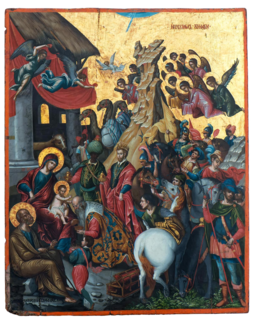 W
WAdoration of the Kings also known as the Adoration of the Magi is a popular tempera painting by Greek painter Michele Damaschino. The painting is roughly the same size as Damaschino's The Last Supper. Both paintings were created around the same period. Michele Damaschino painted in parts of Italy and Greece. He was primarily active in Heraklion, Sicily, and Venice. He is a major representative of the Cretan Renaissance. He was a Cretan Renaissance painter who painted in the Greek mannerisms prevalent at the time. He also blended the style with the Venetian technique creating a new prototype of painting. He was followed by countless artists both Greek and Italian. His version of the Adoration of the Kings is a very important painting because it reveals the mixture of painting styles prevalent in most of his works. The Adoration of the Kings is now in the Monastery of Agia Aikaterini in Heraklion, Crete. It is part of the collection of Saint Catherine's Monastery Mount Sinai, Egypt.
 W
WThe Beheading of John the Baptist was a painting made of egg tempera and gold leaf. It was similar in length to Damaschino's Stoning of Stephen. Michele Damaschino was a famous member of the Cretan school of painting. His contemporaries were El Greco and Georgios Klontzas. Damaschino was from Crete, he spent a large amount of time in Venice. While in Venice, and other parts of Italy, he adopted Italian mannerisms which he applied to his painting technique. The Beheading of John the Baptist was a popular theme among Greek and Italian painters.
 W
WCrucifixion of Saint Andrew is a tempera painting by Greek painter Michael Damaskinos. Damaskinos painted in Heraklion, Venice, Sicily, and other parts of Italy. He was associated with the Greek church San Giorgio dei Greci in Venice. His painting of the Crucifixion of Saint Andrew follows the traditional Greek mannerisms prevalent at the time. It is a rare painting of Andrew the Apostle crucified in the same style as his brother Saint Peter. Saint Peter refused to be crucified the same way as Jesus. He was crucified upside down. Saint Andrew is typically crucified in the form of an X rather than the cross. He was crucified in Patras where his remains can be found today at the Cathedral of Saint Andrew, Patras. The Damaskinos painting of the Crucifixion of Saint Andrew can be found at the Byzantine and Christian Museum in Athens, Greece.
 W
WThe Stoning of Saint Stephen is an egg tempera and gold leaf painting created by Greek master Michael Damaskinos. He was a member of the Cretan school. He integrated Venetian painting with the Greek mannerisms prevalent at the time. Damaskinos was active in Heraklion, Sicily, Venice, and other parts of Italy. The Stoning of Stephen has been depicted by countless Greek and Italian painters. Saint Stephen was a protomartyr. He was the first martyr of Christianity. He was stoned to death for following the new faith. The painting is a depiction of that event.
 W
WThe Last Supper is a tempera painting by Greek painter Michael Damaskinos. He painted in Heraklion, Sicily, Venice, and other parts of Italy. His painting of the Last Supper is considered the Greek Last Supper and is comparative to Leonardo da Vinci's masterpiece painted one hundred years prior. The two painters employed different painting styles but the subjects pose similarities. Damaskinos's painting features a feminine figure similar to that of Leonardo da Vinci's The Last Supper. The Damaskinos Last Supper is now in the Monastery of Agia Aikaterini in Heraklion, Crete. It is part of the collection of Saint Catherine's Monastery Mount Sinai, Egypt.
 W
WThe Virgin of the Burning Bush was a painting made of egg tempera and gold leaf on a wood panel. The portable icon was signed by Greek painter Michael Damaskinos. Damaskinos has over 100 known works. He was a distinguished member of the Cretan school of painting. He was from Crete. His contemporaries included Georgios Klontzas and El Greco. Damaskinos spent over twenty years traveling all over Italy. He spent a significant time in Venice. He adopted Italian artistic mannerisms which he applied to his paintings.
 W
WWedding at Cana also known as Wedding Feast at Cana and Le Nozze di Cana is an oil painting by Michael Damaskinos. He was active during the second half of the 16th century in Heraklion, Sicily, Venice, and different parts of Italy. Over 100 works are attributed to the artist. Most of his work resembled the Greek mannerisms prevalent at the time also known as maniera greca. He was clearly influenced by Venetian painting. His version of the Wedding at Cana was a copy of Tintoretto's massive painting of the Wedding Feast at Cana. The monumental canvas was 4.4 m x 5.9 m or 14.4 ft x 19.3 ft. The painting was originally in the dining hall (refectory) of the convent of the Crociferi in Venice. Refectories typically featured large paintings of biblical banquet scenes. The monks preferred biblical banquet scenes because they desired the impression of dining with Christ. Damaskinos probably saw the painting at the convent or a copy of the masterpiece in Venice. The Damaskinos version is much smaller than the original. The painting is very important because it is one of the few instances where Damaskinos broke from the traditional maniera greca prevalent in most of his works. In this instance, he strictly followed the lines of Venetian painting exhibiting his superior craftsmanship as a painter capable of changing his style. El Greco was another painter who also painted in both styles. The Damaskinos version is currently at the Museo Correr in Venice, Italy.